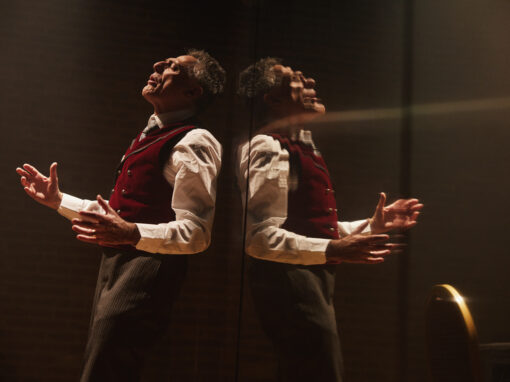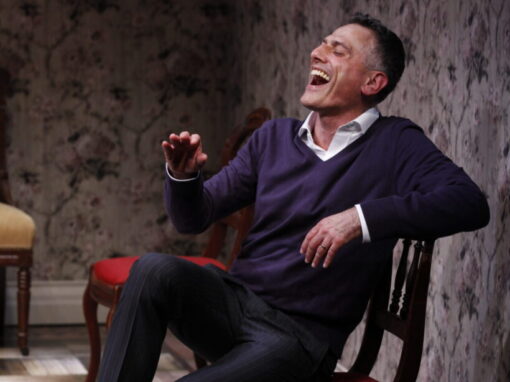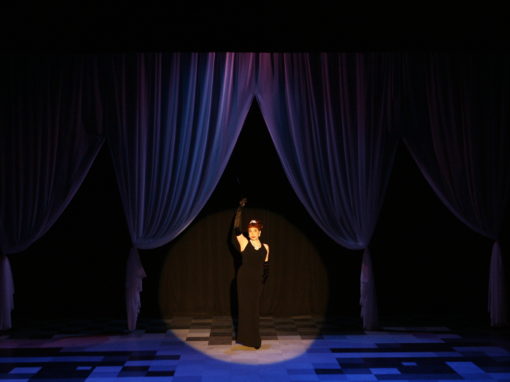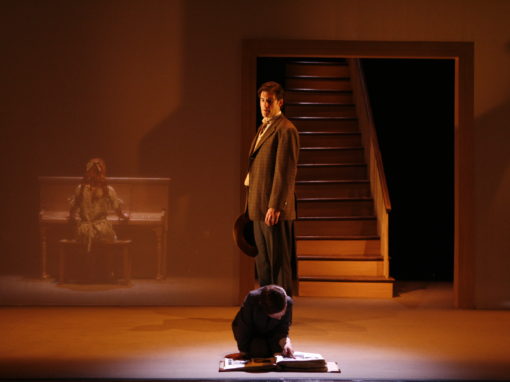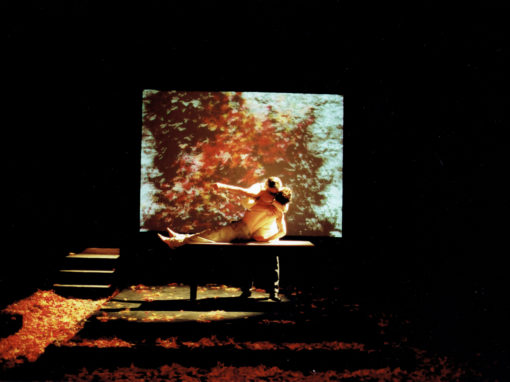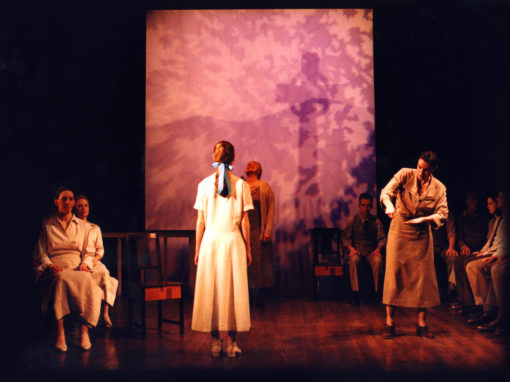Trusting The Unknown // by Kevin Paley
Director Kevin Paley finds new facets of their relationship with gender in the rehearsal room.
If you ever find yourself questioning your gender identity, here’s one piece of advice: get out of Nebraska.
In the summer of 2018, I found myself taking on roles like Billy Lawlor in 42nd Street and Willard Hewitt in Footloose, in the middle of nowhere Nebraska. Somehow, the art of portraying these men led me to a shocking conclusion: that I was anything but. I felt like a Transgender diamond, pressurized by this midwestern microcosm of the patriarchy. I bought my first few dresses at a thrift store in a nearby town; there were two stores, but only one let me shop on the women’s floor.
I assumed that when I returned to New York, life would be easy. I decided to take a break from theatre to work on myself. Quickly, I learned that life was not easy, and if I was going to find inspiration anywhere, it would be in the arts. That’s when Transport Group’s 2019 revival of The Trial of The Catonsville Nine came along.
In 1968, nine Catholic activists raided a draft board in Catonsville, Maryland; they burned 378 draft files in the parking lot using homemade napalm in protest of the Vietnam war. They were peacefully arrested by the cops and their court transcripts were adapted into a play: our source material.
Director Jack Cummings III cast Mia Katigbak, Eunice Wong, David Huynh: three Asian-American actors, in the hopes of finding a new story to tell. The concept of gender did not inform which actor played each of the Nine; rather, actors were divided amongst the Nine by essence. Our show was non-binary too.
What does it mean to ignore gender by focusing on essence?
In my interview with Jack to assistant direct the show, he admitted, “I don’t really know exactly what it’s going to look like. But I have some ideas.”
“I love that.” I probably said. But I did not love that. I feared that. In a long list of fears, the Unknown was probably at the top. I had found relative success combatting fear with preparation. It’s hard to prepare for the Unknown.
If you know Jack, you know that he’s not one to avoid the elephant in the room (in this case the elephant being my Transness). He’ll see it, politely walk up to it, and say, “Out of respect, not being an elephant, how might I properly respect you?”
We talked about pronouns, about names, and he told me about his former professional tennis player sister competing against Trans Legend, Renee Richards, years ago. I admitted that I was taking a break from sports and working out in an effort to “feminize my body.” I joked that I certainly wasn’t passing for a woman any time soon—probably as a projection of my own insecurity more than anything else.
I am six feet tall, broad-shouldered, and have five-o-clock shadow twenty-four hours a day. I lived the first twenty-four years of my life on autopilot with my subconscious programmed to suppress feminine impulses. A simple decision to “let go of masculine conditioning” was not about to make the world see me how I saw myself.
Leading up to the first rehearsal, I attempted to lock down my identity. I enrolled in a Transgender support group. I hired a gender coach. I stopped lifting weights and started shaving my legs.
I e-mailed my co-assistant director, MaryKate Glenn, a greeting with some alternative names to Kevin that I happened to be “trying on” at the time. I realized that I forgot to disclose my Transness when MaryKate’s response came with the admission that she had no fun nicknames (but she was willing to explore new ones).
One of the most common pieces of advice I hear from the Transfeminine community about coming out is to surround oneself with a group of affirming, positive women, and Trans role models.
I have to laugh when I think back on this rehearsal process. I was spoiled. There I was trying to prove to everyone that I was a finished product amidst the weeks we spent building a work of art from the ground up.
I learned that adapting to a creative process with an amorphous final product takes trust in one’s collaborators. Congruently, adapting to a lifestyle with a fluid identity takes trust in oneself and in one’s community. I’m not sure I ever adequately thanked the creative team for how much they helped to reshape my understanding of gender at a pivotal time in my life.
In the way that a duckling sees a grown duck and follows, I observed the women around me.
I saw actress Eunice Wong doing headstands during breaks and thought, “Who am I trying to feminize my body for?”
I saw dramaturg Krista Williams posing queries without apology and thought, “Who am I minimizing myself for?”
Mia Katigbak called me ageist and I thought, “Well, I must be ageist.” I learned of the love in holding someone accountable.
I was inspired by these women and felt a certain kinship. Yet, every commute to and from rehearsal was loaded with relentless ridicule. Each morning, I faced a choice: do I dress the way society expects me to dress, and just get by? Or do I dress the way I want to dress, and endure?
Every day, Mia would enter rehearsal with a smile on her face. Before she could take her seat, she would compliment me on a new outfit, new pair of earrings, or new makeup choice. Through Mia, I learned my favorite lesson: a single, loving gesture outweighs a thousand jeers.
I found comfortability with my Transness in a room full of cisgender collaborators. Life in the rehearsal room was not determined by gender, sexuality, race, or status. Rather, I believe we inadvertently adhered to an order spoken of by Daniel Berrigan, leader of the Nine:
We say: killing is disorder
life and gentleness and community and unselfishness
is the only order we recognize.
I think the most beautiful part about this experience is that my collaborators became my heroes without any encouragement or any reward. They were just being themselves.
Here’s the best example:
Just like “I love you,” there’s another three-word phrase that can make a lot of people feel a certain type of way: post-show talkback.
When you’ve just had the pleasure of sitting across from your fellow audience members and witnessing all of their reactions, be they good, bad, or anomalous, the talkback comes with few surprises.
A woman in her sixties or seventies raised her hand.
At this point, I’d developed a kind of fondness for the tales folks shared about living through the Vietnam War. These anecdotes were often accompanied by an extension of gratitude to the actors and creative team for a job well done.
I leaned forward, eager to hear in what specific way we had managed to inspire this woman and renew her faith in humanity that evening.
“Why did you have a woman play Daniel Berrigan?”
She mentioned that she knew of Daniel when she was younger, and she believed that he would not have been as emotional as the actress portrayed him.
She added that the moment might have been more accurate if a man had played the part.
Immediately my defensive brain fired off several vicious remarks:
- Let’s begin by unpacking your projection of how you think Daniel would have said these words.
- Do we want to discuss your projection of how a man vs. a woman might be inclined to act?
- How about we stage an eight-hour docudrama based on the court records, cast true to gender and age. Let’s see you stay awake through that.
Luckily, Eunice (who played Daniel Berrigan) had decided to stick around after the show. She removed her beanie. I grinned. I wished I had popcorn.
She thanked the woman for her question.
Ugh, she’s so nice. I thought. How does she do it?
Eunice spoke to the responsibility that artists have to dig at what’s beneath the surface and how, through this inquiry, we are able explore and reveal what it means to be human.
Eunice spoke to the choices artists have when it comes to storytelling and the privilege of imagining new worlds.
She continued to explain that in the case of our production, the notion of gender seemed insignificant in comparison to the rich thematic content—the Nine were defined by their united effort to enact social change and little else.
The woman’s reaction to this atypical storytelling approach is the same reaction that I get while riding the subway: I’m not used to this and it confuses me.
That’s when I realized that a show’s creative process is the journey of self-discovery. And the journey of owning one’s identity is the process of trusting one’s own creative process.
Identity exists in a continuum. We are a product of what we have been and what we yearn to be. Our labels name where we are in our journey at any given time.
Where we were, at that time, was a place where individual ideas and qualities took precedence over socially constructed facets of identity. That’s how I’ve come to view people: as a sum of ideas and qualities. Our play came to be non-binary, and so did I.
I don’t think I’ll worry so much about the finished product anymore; I trust the process.

About the author:

Explore Our Past Shows

